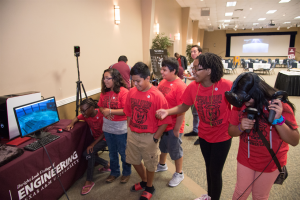Last week, I found myself in a roundtable discussion with 5 other educators, each of them current middle school or high school teachers. What started out as an initial conversation about asking purposeful questions quickly lead to a much lengthier, deep dialogue about creating opportunities for student inquiry and our learning environment!!

During our conversation, I listened to the teachers share their concerns about the lack of engagement and ownership in the learning process by their students as well as their struggle to get students involved in meaningful discourse. My heart went out to them, clearly these educators had an immense amount of passion and wholeheartedly wanted their students to succeed. After listening to them for about 45 minutes it became evident to me that it wasn’t that the teachers were struggling to ask the right questions….they were struggling to ask them the right way!
What I noticed was that each of the teachers were asking thought provoking, higher level questions to their students which is a good thing, the only problem is that the teachers were asking the questions. All that the students were required to do was to listen and answer the questions, the teachers weren’t asking them to engage with the content in any meaningful way. At the end of our collaboration time, I gave each of the teachers a bit of a homework assignment, I asked them to research the QFT (Question Formation Technique), create a QFocus to use with their students, bring their lesson and reflections back with them the next time we met.
For those not familiar with the QFT here is a BRIEF overview:
The Question Formation Technique is a multi-step process that is used to help students produce their own questions centered around a Question Focus (QFocus). Here is a great resource that outlines the steps in more detail.
 There was an excitement in the air the next time we met, these colleagues were rejuvenated and excited about the learning that took place in their classrooms! Our discussion this session was much different, the teachers were talking about how impressed they were by their students ability to ask thought-provoking questions, the level of ownership and engagement, and students’ ability to follow the rules. After we shared out the positives with the new inquiry model, I asked them to discuss any negatives, to my suprise the negatives comments were that if QFT was used too often it can lose its luster and engagement would decrease again, the other comment was that the students wanted to do these types of activities everyday and the teacher I was working with said that was just not realistic.
There was an excitement in the air the next time we met, these colleagues were rejuvenated and excited about the learning that took place in their classrooms! Our discussion this session was much different, the teachers were talking about how impressed they were by their students ability to ask thought-provoking questions, the level of ownership and engagement, and students’ ability to follow the rules. After we shared out the positives with the new inquiry model, I asked them to discuss any negatives, to my suprise the negatives comments were that if QFT was used too often it can lose its luster and engagement would decrease again, the other comment was that the students wanted to do these types of activities everyday and the teacher I was working with said that was just not realistic.
While I was happy to hear that implementing the QFT was a success, I was disappointed that the teachers couldn’t see the connections to the QFT and other inquiry focus lessons they could implement so that we didn’t loose engagement again.
Here are a few suggestions/activities on how to continue to create classrooms where curiosity, creative thinking and collaboration thrive:
- Repeat and Add On
-
-
- Encourage students to share ideas and connect to a classmate’s ideas. Students learn to listen and develop their own ideas.
- Example: “You said that recycling is becoming a problem and not a solution to landfills filling up because people are putting non-recyclable items in the recycling bin. I also think that recycling is becoming a problem and not a solution to landfills filling up because people are putting non-recyclable items in the recycling bin, and I also think that they are doing that because they aren’t aware of what can be recycled and what can not.”
- Encourage students to share ideas and connect to a classmate’s ideas. Students learn to listen and develop their own ideas.
-
- Four Corners

-
-
- Give students an opportunity to take a stand and defend their thinking
- For questions that have multiple possible answers and/or perspectives, put four different answers to the question in the four corners of the room. Ask students to go to a corner, discuss the topic with the other students in the corner, and then support and defend their choice to the rest of the class.
- Give students an opportunity to take a stand and defend their thinking
-
- Source Swap
-
-
- Help students collaborate in order to efficiently construct meaning.
- Have each student find a website or a video in support of the topic(s) under study. For example, if studying Earth’s features, students may choose a feature (trenches, ridges, mountain ranges, etc.) and find a source with information about their chosen feature. Once they have reviewed their source they trade with another student and review the new source. The pairs then discuss the two sources and decide how to use the information as reasoning to support their claim
- Help students collaborate in order to efficiently construct meaning.
-
- Messing About
-
-
- Messing about is curiosity’s best friend!

- Before moving directly into an investigation, allow time for students to “mess about” with materials and supplies to begin exploring and building interest in phenomena. During this experience, students can brainstorm questions they are interested in exploring later, while also building the prerequisite knowledge and experience they need to be successful in the investigation. Messing about builds curiosity and engagement.
- Messing about is curiosity’s best friend!
-
- Give One, Get One
-
- Build collaboration skills and social-emotional skills at the same time.
- Have students number their papers 1-5. Give them the topic you are about to study and have them write down 3 things they know about the topic. After they’ve written down 3 things, they move around the classroom and ask another student for a 4th piece of information and they share one of their ideas. They find a different student and repeat the process for a 5th piece of information. They learn you get more ideas when you collaborate and they learn you that sometimes you need to give in order to receive.
- Build collaboration skills and social-emotional skills at the same time.
https://vaei.vai.org/wp-content/uploads/sites/6/2018/05/LE-Strategies-EBook_May2018.pdf
Obviously these are just a few of the MANY ideas you can immediately implement in your classroom to increase student engagement, risk-taking, collaboration & student choice. Are you looking for more information on QFT and other ways to make your questions count?? Check out this 100% ONLINE professional learning opportunity – trust me, you won’t be disappointed!
 Katie Algrim – Director of Innovative Professional Learning
Katie Algrim – Director of Innovative Professional Learning
(t):630-444-3044
(c):630-675-4447
(e):kalgrim@kaneroe.org


